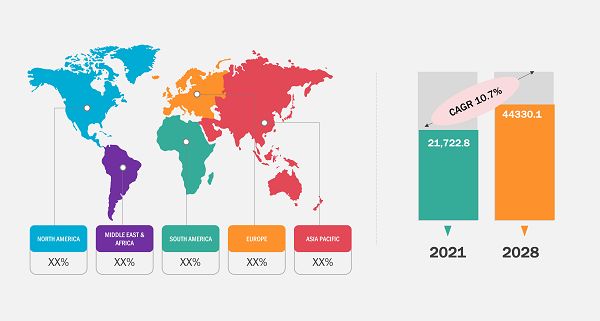Growing Awareness Regarding Benefits of Cell-Based Vaccines Drives Cell Culture Market
According to our latest study on "Cell Culture Market Forecast to 2028 – COVID-19 Impact and Global Analysis – by Product, Application, End User, and Geography," the market was valued at US$ 21,722.8 million in 2021 and is likely to reach US$ 44,330.1 million by 2028; it is expected to grow at a CAGR of 10.7% from 2022 to 2028.
Cell Culture Market Size and Forecasts (2021 - 2031), Global and Regional Share, Trends, and Growth Opportunity Analysis Report Coverage: by Product (Consumables and Equipment), Application (Biopharmaceuticals, Drug Screening and Developments, Tissue Engineering and Regenerative Medicines, Diagnostics, and Others), End User (Pharmaceutical and Biotechnology Companies, Hospitals and Diagnostic Laboratories, Research and Academic Institutes, and Others), and Geography (North America, Europe, Asia Pacific, and South and Central America)
Cell Culture Market Size and Share: 2031 Key Findings
Download Free Sample
Source: The Insight Partners Analysis
Increasing awareness regarding the benefits of cell-based vaccines and the surging demand for monoclonal antibodies are boosting the cell culture market growth. Furthermore, funding for cell-based research is growing due to the increasing preference for single-use technologies and the rising need for personalized medicine. Moreover, the increasing number of advanced cell culture product launches and FDA approvals for personalized medicines are expected to create opportunities for the market during the forecast period.
The cells used to manufacture vaccines are frozen or banked, ensuring an adequate supply of cells for vaccine production. The adoption of cell culture vaccines has grown in recent years due to potential applications in developing viral vaccines, particularly for influenza.
The increasing incidence of infectious diseases, such as common cold, diphtheria, E. coli., giardiasis, HIV/AIDS, and the growing risk of COVID 19 outbreak are anticipated to drive vaccine demand worldwide in the coming years. For instance, in India, almost everyone experiences a common cold twice a year, accounting for at least 40–50% of new cases of common cold. Additionally, as per the National Centre for Disease Control (NCDC), in 2019, 28,798 H1N1 cases and 1,218 deaths were reported. Cell culture has become a prominent part of vaccine production in the pharmaceutical industry. Cell culture technology has produced vaccines for rotavirus, polio, smallpox, hepatitis, rubella, and chickenpox.
Key players involved in the cell culture market are undertaking initiatives to extend their product portfolios and strengthen their market position. For instance, in January 2022, Cytiva (Danaher Corporation) collaborated with Nucleus Biologics to develop custom culture media for cell and gene therapies. Furthermore, market players are making developments in their existing service offerings to improve their market presence. For instance, in February 2022, KromaTiD expanded its service offerings by launching cell and blood culture isolation, processing, and quality control services. Additionally, in November 2019, Thermo Fisher Scientific announced the investment of US$ 250 million in the US, India, the UK, Argentina, and China. The investment would boost its ability to manufacture cell culture media and expects to complete the work by 2021.
Thermo Fisher Scientific Inc.; Merck KGaA; Danaher Corporation; Corning Incorporated; Eppendorf AG; FUJIFILM Irvine Scientific, Inc.; Lonza Group AG; Sartorius AG; Agilent Technologies, Inc.; and Getinge AB are among the key players profiled during the study of the cell culture market. Several other major companies were studied and analyzed during this research study to get a holistic view of the market and its ecosystem.
Contact Us
Phone: +1-646-491-9876
Email Id: sales@theinsightpartners.com